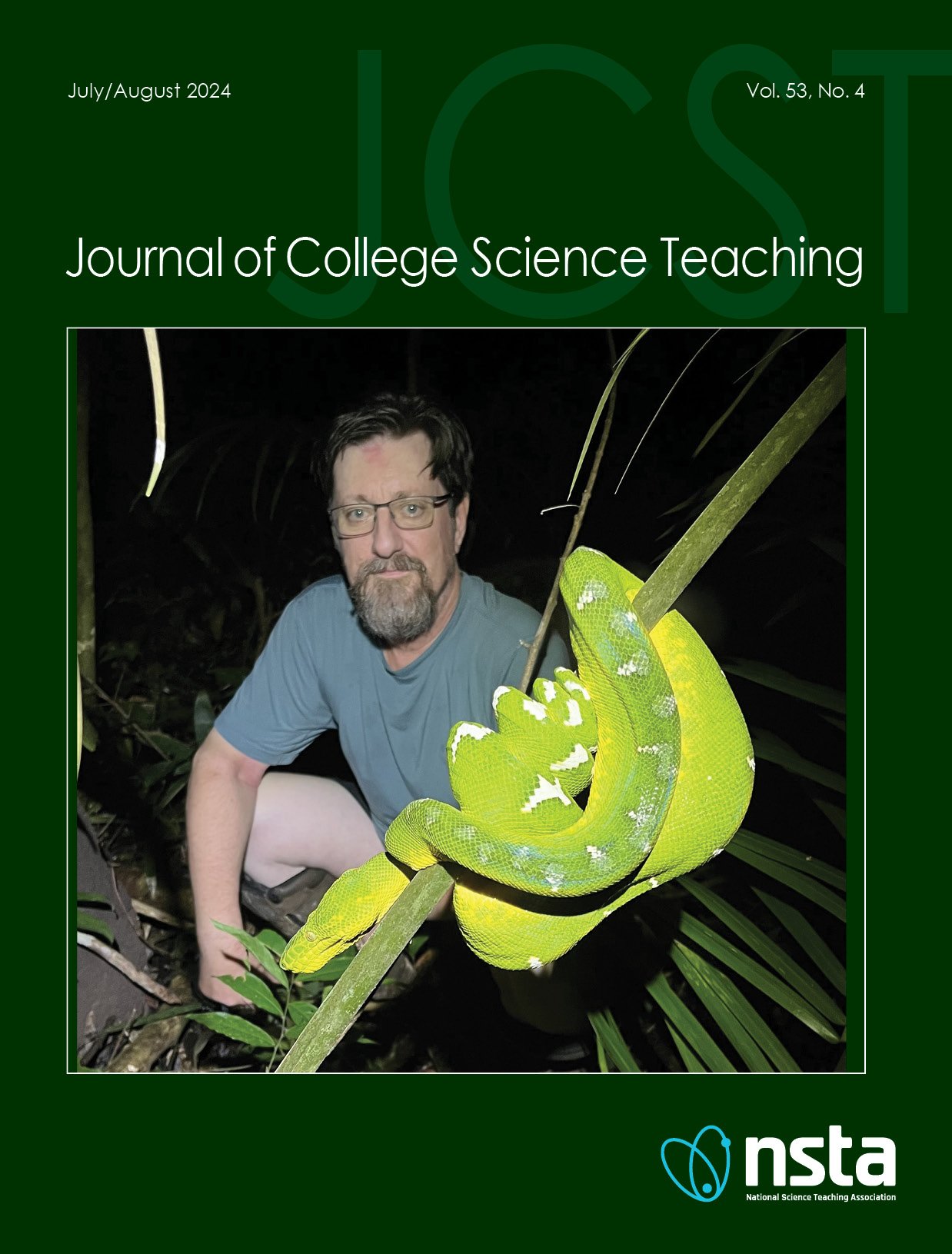All Resources
Web Seminar
Join us on Thursday, November 21, 2024, from 7:00 PM to 8:00 PM ET, to learn about NSTA'...
Web Seminar
This interactive web seminar will begin with an overview of safety protocols specific for doing secondary-level safer science/STEM laboratory activities. The presenters will be Dr. Ken Roy, NSTA and NSELA Safety Compliance Advisor/Specialist and Dire...
Web Seminar
This interactive web seminar will begin with an overview of safety protocols specific for doing elementary level safer science/STEM classroom/laboratory activities with Dr. Ken Roy, NSTA and NSELA Safety Compliance Advisor/specialist and, Director of...
Web Seminar
In this web seminar, a panel of early childhood science teacher educators/researchers will define high quality early childhood science education, elicit challenges from participants, and present current research in addressing these challenges. This ...
Journal Article
Right to the Source...
By Kelsey Beeghly
Journal Article
Teaching Physics as the Awesome Rules of Nature
Focus on Physics...
By Paul G. Hewitt
Journal Article
Equitable Science for a Socially Just Classroom
Editor's Corner September/October 2024...
By Brooke Whitworth
Journal Article
Finding Instructional Resources for Teaching about Scientific Misinformation
A classroom guide to resources about misinformation...
By Andy Zucker
Journal Article
Reimagining Science as a Natural Tool for Connection: A Restorative Approach
This paper explores a restorative-type intervention with a high school student who is suspended from school for repeated threats to other students. Throughout the paper, we explore the use of restorative practices in the context of science teaching. ...
By Zachary Schafer
Journal Article
“Black is Beautiful”: A Culturally Relevant/Responsive High School Biology Lesson
This biology lesson uses the science of central dogma to “critique and question the politics of representation that systematically devalue[s] Blackness” (hooks, 1995, p.131). Students’ understanding of protein synthesis is extended in discussin...
By Eddie Taylor
Journal Article
Making chemistry relevant to Indigenous Peoples: An Inuit case study
The ability of our northern Indigenous peoples (Inuit, Iñupiaq, and Yupik) to survive and thrive in the Arctic depends significantly upon underlying chemistry and chemical principles. Here, we explore four of these connections, then show how the Ind...
By Chaim Andersen, Rosalina Naqitarvik, Jennifer Winters, Erica Taylor, Geoffrey Rayner-Canham
Journal Article
Science classrooms are most engaging when students have the opportunity to engage in the practices of scientists. Unfortunately, many attempts to incorporate science into the classroom are disconnected from real scientific practice. When classroom sc...
By Ari Geary-Teeter, Thomas McKenna
Journal Article
Researchers have long called for integrating socio-scientific issues (SSIs) in science instruction, recognizing the importance of connecting science learning with societal challenges. Our proposed three-day unit design addresses SSIs in secondary sch...
By Mutiara Syifa, Fuyi Feng, Chia-Hsin Yin, Lin Ding
Journal Article
Cultivating Teachers’ Indigenous Knowledge through Explorations of Milkweed and Phenology
Providing more equitable pedagogies to all students, including those who are traditionally underrepresented, is a high priority of science education. In this paper, we outline how we coupled Indigenous Ways of Knowing with investigations about plant ...
By Hillary Barron, Emily Mohl, Michele Koomen
Journal Article
Determining the Relative Mass Between the Nucleus and Electrons Modeling Lab
Freshman general science students already know the atom is composed of a nucleus containing protons and neutrons with electron circling the nucleus. This hands-on modeling lab allows students to visualize and discover the electrons mass is far less a...
By Gary Schlitz
Journal Article
Students with Visual Impairments can be Successful in Science
One of the goals of the Next Generation Science Standards is to make science accessible to all students, which includes students with disabilities such as blindness and visual impairments (BVI). However, educators of students with BVI have limited ex...
By Rhea Miles
Journal Article
All students should have opportunities to investigate issues related to their personal interests and community priorities. Teachers value these goals but often lack materials that follow students' meaningful questions about phenomena while meeting st...
By William Penuel, Kate Henson, Zoë Bracey, Nicole Vick, Ann Rivet
Lesson Plan
Journal Article
Uncovering Earth’s History, One Sample at a Time
Teaching Through Trade Books...
By Christine Anne Royce
Journal Article
This paper discusses two teachers’ experiences implementing a phenomenon and problem-driven curriculum for the first time in two kindergarten classes. It describes how teachers shifted their teaching to support students’ collaborative sensemaking...
By Mary Short, Nancy Costanzo, Allison Fleming
Journal Article
Making Space for Local Science: Strategies for teachers to find and adapt phenomena in science units
This article discusses strategies for teachers to find and use local phenomena in designed science units. The Next Generation Science Standards promote grounding learning in observable phenomena that students investigate using science practices. Howe...
By Katahdin A Whitt, Becky Hallowell
Journal Article
Dog Days At School: Using Authenticity to Guide cross-curricular Learning in Kindergarten
The presented unit explores the often-overlooked potential of integrating science, social studies, math, and ELA through the lens of a kindergarten unit centered around the creation of a dog park. Emphasizing collaborative decision-making and communi...
By Amanda Sanderman, Chelsie Byram
Journal Article
Learning to be an Ambitious Science Teacher
Since the release of the Next Generation Science Standards (NGSS), students are expected to learn science according to the three-dimensions (DCI, SEP, CCC). In order for teachers to support the three-dimensional learning of their students, they need ...
By Alex Gerber, Heather Milo
Journal Article
The emperor penguin is one of the most identifiable animals on earth. Its survival depends on a variety of factors, such as temperature and other environmental elements. In order to engage fifth-grade students in exploring the captivating phenomenon ...
By Robyn Yewell, Ron Gray
Journal Article
Mapping in Two and Three Dimensions
Second graders used their own school-ground explorations, using journals and iPads for pictures and narrated videos, to create traditional, two-dimensional models of their school-grounds and all its natural and human-made features. These data collect...
By Jeffery Townsend, Connie Hodge, Sonja Yow, Whitney Cox
Journal Article
Q: How can I address science misconceptions using phenomena-driven instruction?
Q: How can I address science misconceptions using phenomena-driven instruction?...
By Matthew Bobrowsky
Journal Article
Integrating engineering into the science curriculum in a meaningful way requires planning that utilizes a 3-dimensional approach. Using a “gather, reason, communicate” framework (Moulding, Huff, Van der Veen, 2020) provided me with an effective ...
By Katheryn Kennedy
Journal Article
For preservice K–5 teachers, understanding how to implement phenomenon-based learning in an elementary classroom is an important skill, particularly as it relates to integrating the Next Generation Science Standards. This article presents one way t...
By Steph Dean
Journal Article
In this article, we describe how we use classroom phenomena to help fifth grade students develop testable questions and productive investigations. Engaging students in observing and seeking to explain a classroom decomposition chamber has helped them...
By Eve Manz, Annabel Stoler, Lorin Federico, Samantha Patton, Lindsay Weaver, Genelle Diaz Silveira, Souhaila Nassar





